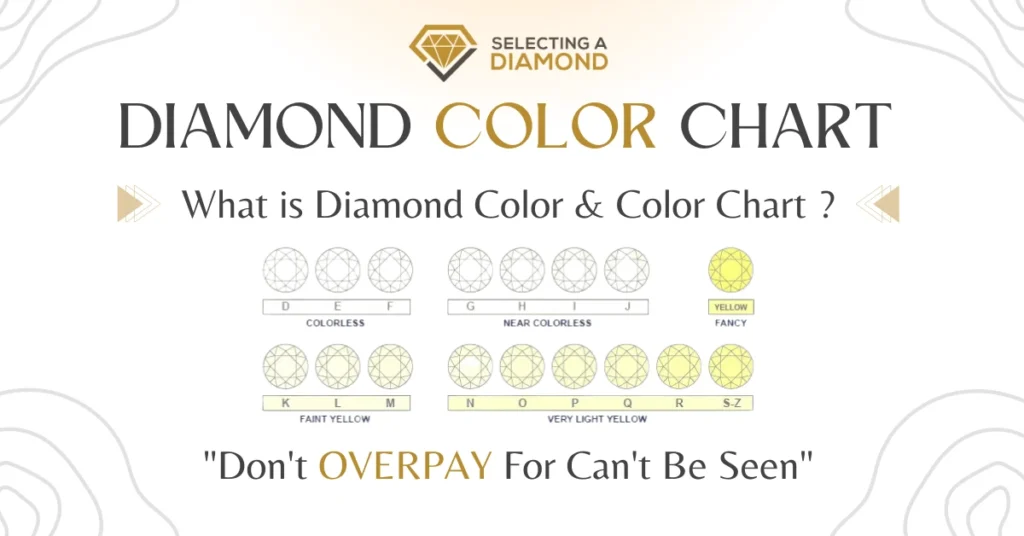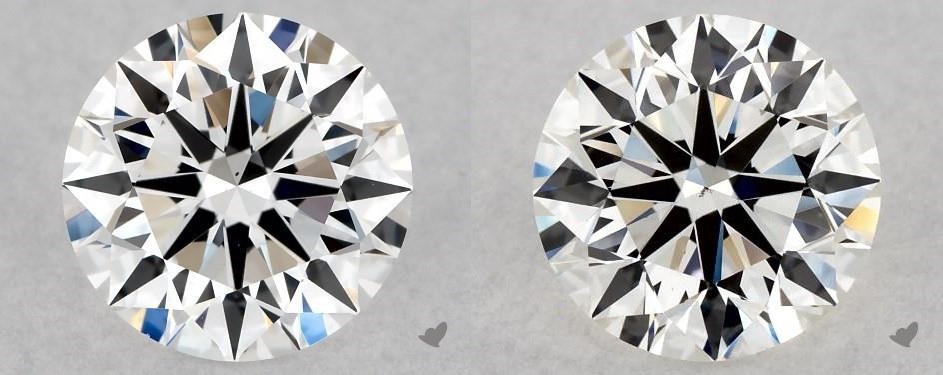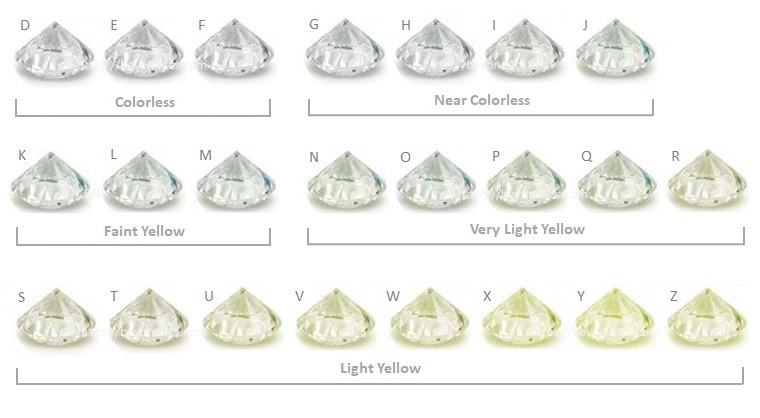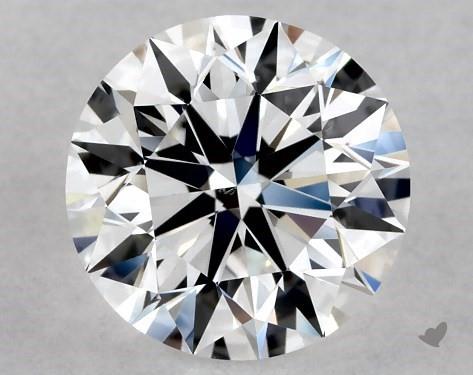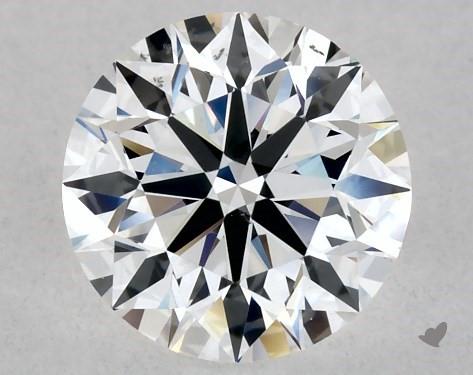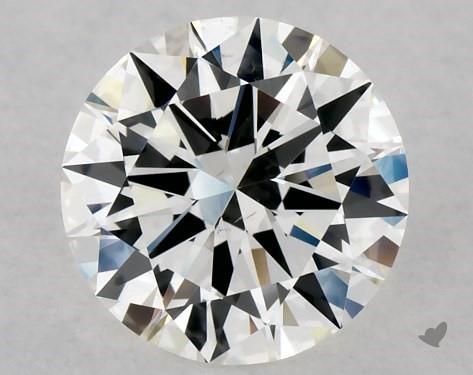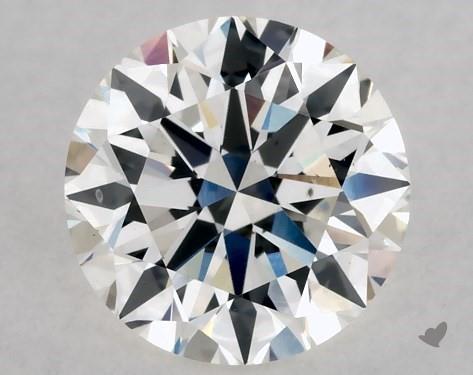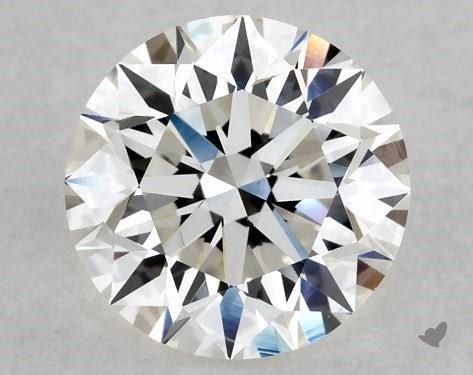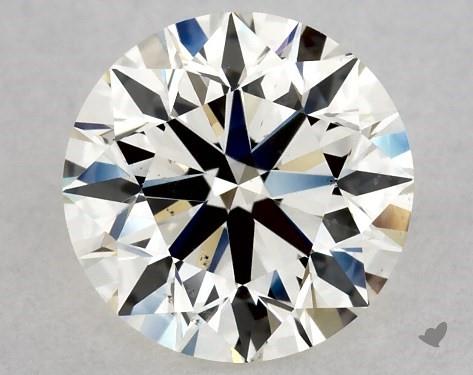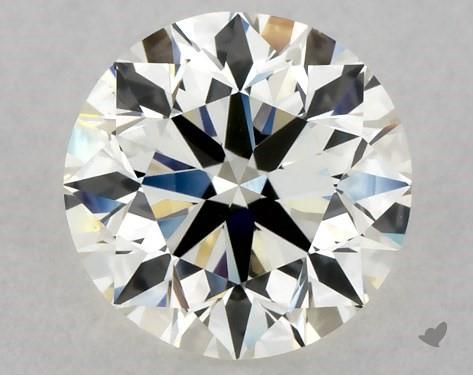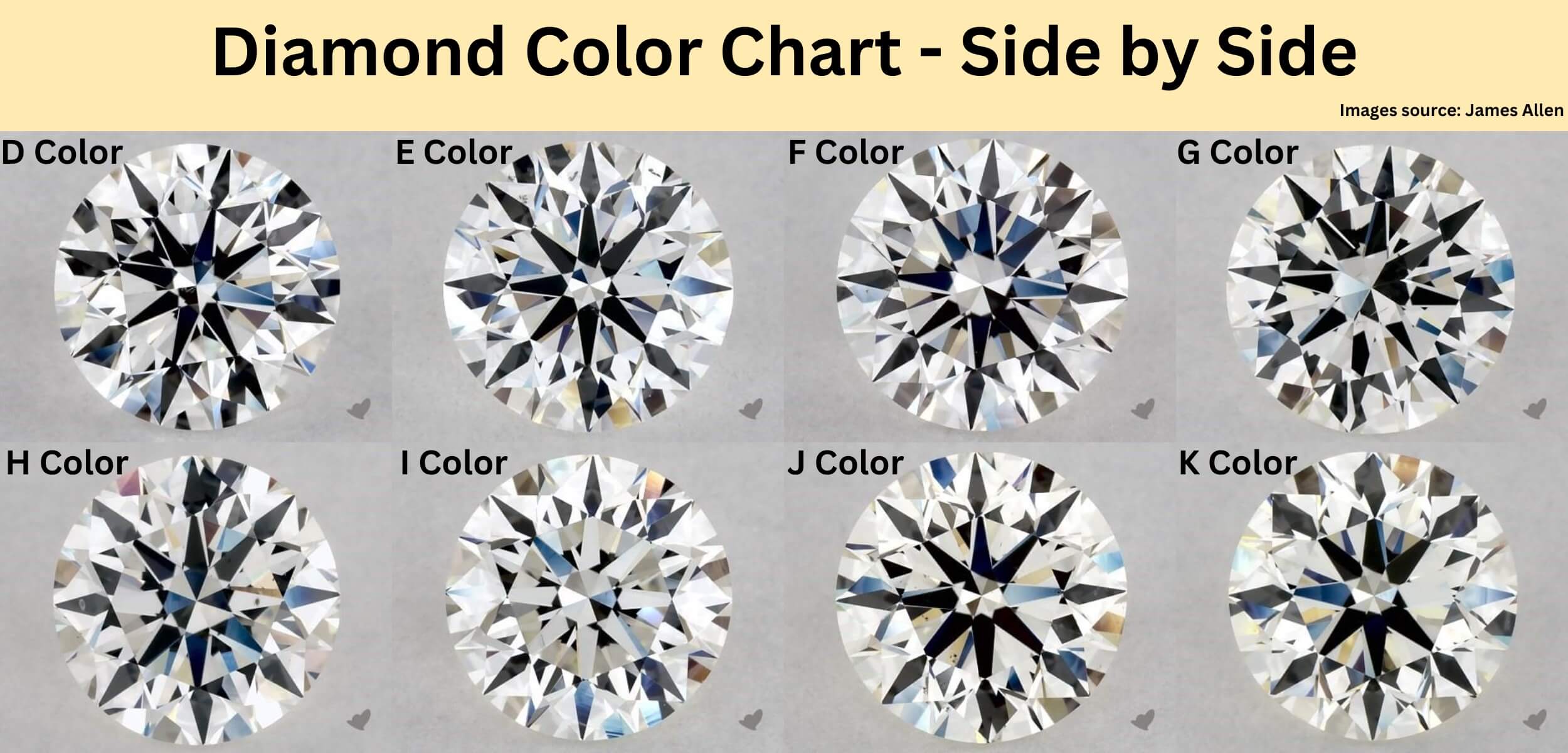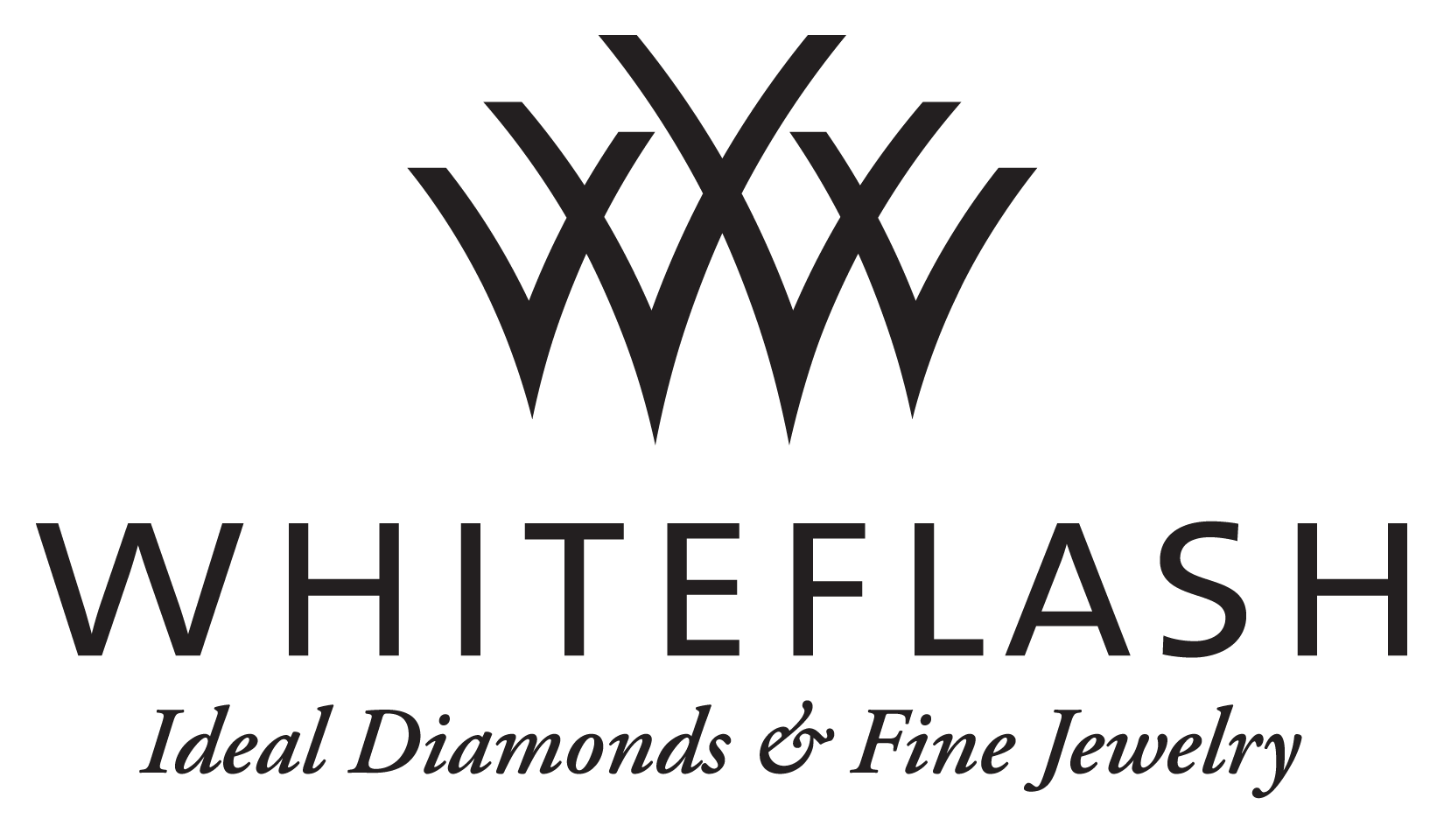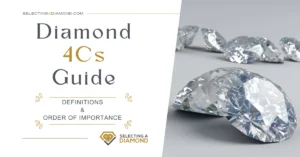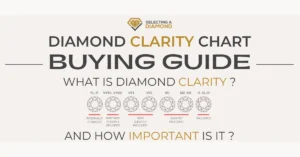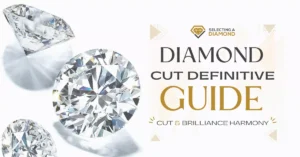We may earn a commission when you purchase through our affiliate links, at no extra cost to you. This helps support our work and allows us to continue providing unbiased, expert diamond advice.
Summary in a few lines:
GIA grades diamonds with letters from D to Z, with D being purist, most colorless diamond grade, and Z as the last grade with light yellow.
The higher the grade, the more expensive the diamond, with an exception to fancy color diamonds of course.
It’s not necessary to go extremely high in grade in order to avoid yellow color in diamonds, for instance, here is an amazing 1 carat G color diamond on James Allen, check how “pure” it is.
Then compare it to this similar diamond with an E color (but $800+ more expensive), do you see a huge difference in color keeping in mind these are 20 magnified images?
We believe it’s crucial to understand the diamond color chart, how much visual difference is there between color grades when viewed by naked eye, and how much this affect diamond beauty.
Let’s get started.
It has always been fascinating to all of us; the ability of women to discriminate among colors and actually seeing more color gradations than men. And for this specific reason, color shouldn’t be taken lightly; especially when it comes to diamond color!
In diamonds, Color is considered one of the main 4Cs of the diamond characteristics. It’s also one of the most important aspects to look at when considering buying any diamond.
Pro Tip: We said “one of” and not the most important, because we know for a fact that in order of importance, Cut takes the lead.
What is Diamond Color Grade?
Diamond color is an representation of how much color a diamond has, and it’s usually graded by a letter (number in AGS standards) based on how much yellow color the diamond has, diamonds are valued by how closely they approach colorlessness, in other words, the less color, the higher the price.
Diamond color is graded on a scale from Colorless to Yellow; colorless means that the diamond is pure like water, you can never identify (under any circumstances) any yellowish appearance with your naked eyes.
GIA started this grading system, and on a diamond certificate or when looking at diamond characteristics online, you will clearly see single letter notations starting from D for colorless (most valuable) down to J for the lowest graded near-colorless diamonds (before getting light yellow), and then all the way on the scale down until Z.
Look at these two images:
The diamond on the left is this D color diamond, on a standard diamond color scale, this diamond has absolutely no color, that’s why it’s priced at $7,590 (1 carat), while an “almost” identical gem in all other factors (clarity, cut, polish, and symmetry) but with a J color (the left one) is priced at almost 60% of the D-color one, for the sole reason that it has a J color!
So what’s the deal here exactly?
One point though, we focus in this article only on the common diamond colors (D to K), since lower grades aren’t common and not preferrable by most people, keeping in mind that this doesn’t include Fancy color diamonds.
What is Diamond Color Scale (Chart)?
When GIA wanted to define & grade diamonds based on their color, they came up with a diamond color scale, which is now a reference for most reputable certification labs out there.
The scale is organized in two levels:
- Each grade is labeled with a letter that tells how much color the diamond has, D is considered the highest grade possible (no color at all), all the way down to Z (yellow).
- Every set of adjacent letters is grouped into a categorization of how overall this group of grades is standing against having color, the groups are ranging from 3 grades up to 8 grades.
The image here shows how each adjacent colors are grouped, with first group being “Colorless” and last being “Light Yellow”, as you see there is a huge difference between S to Z, but they ended up putting them all together in one group.
Generally speaking, when you’re shopping at major online stores like James Allen, Blue Nile, or Whiteflash, you will see they stop at K color, because lesser color grades aren’t desirable by most people (and market in general).
Do you know that these groups are a very attractive selling points? People will always try to stay in the colorless group, because they think G or H will show some yellow color, and salespeople take this to their advantage, by trying to sell you the highest color grade possible.
That’s why the price difference between F & G colors for example is higher than the difference between E & F, because you’re jumping from a group to another as we will see below!
Diamond Color Chart: Definition & Real Images
Let’s take a look on each color grade, what’s its average price range (so you get an idea of jumps between grades), and actual image for a diamond in that color grade.
We will use James Allen as reference for imaging & pricing, because:
- They have the largest inventory with over half a million diamonds
- Their imaging technology is super, surpassing any other technology available today
No wonder why we recommend them for all our readers, feel free to read our full & unbiased review of James Allen.
Since pricing varies a lot based on a lot of characteristics, we will stick to these:
Cut: Ideal/Excellent
Carat: 1
Clarity: VS2
Polish & Symmetry: Excellent
Fluorescence: None
Grading lab: GIA
Let’s start with the most expensive grade.
1. D Color Grade
D Colorless diamond are one of the most rare diamonds ever, they are truly colorless (along with E grade). D Grade is also one of the most valuable grades you can ever find.
Most gemologist can tell the difference between D & E grades by comparison side by side, only a few of them can detect that in naked eye without having the other grade in hand.
Real Image:
Link to this diamond in 360-degree view.
Price range:
From $7700 – $9500
You can browse D color diamonds on James Allen with the above characteristics with this pre-set search.
2. E Color Grade
E grade is colorless as well, can’t detect any color on it, it’s valuable as D grade (almost), and you need an experienced gemologist to tell the difference between D & E as stated above.
Real Image:
Link to this diamond in 360-degree view.
Price range:
From $7300 – $9100
You can browse E color diamonds on James Allen with the above characteristics with this pre-set search.
3. F Color Grade
F is colorless as well, or let’s say, almost!
Because when a gemologist (not a jeweler) looks at an F grade diamond as faced down, they can notice a very (undetectable) amount of color.
D, E & F grades should be in set of white gold or platinum, because color is reflected in yellow gold, it won’t appear nice because it will negate the colorless effect in those grades.
Real Image:
Link to this diamond in 360-degree view.
Price range:
From $7100 – $8700
You can browse F color diamonds on James Allen with the above characteristics with this pre-set search.
4. G Color Grade
G is the first line of near colorless grades.
It’s the most expensive grade among the near colorless grades, thus, you may see more of I & J in retail markets
And because it’s the most common color grade, we have a dedicated article that reviews G color.
Is G colorless to naked eye? Of course, and we don’t recommend getting more than G color in all cases!
Real Image:
Link to this diamond in 360-degree view.
Price range:
From $6500 – $8000 (noticed the drop between F and G?)
You can browse G color diamonds on James Allen with the above characteristics with this pre-set search.
5. H Color Grade
H is a bit less expensive that G, and in terms of best diamond color in terms of budget, H is the winner.
Untrained eye can’t tell the difference between G & H colors, and if getting G is 100% safe, it’s also a great choice to save some money and get an H color diamond.
And similar to all near colorless grades, it goes best with platinum or white gold settings.
Check our H vs. G color review as it goes in much more details on why getting H is something you should consider.
Real Image:
Link to this diamond in 360-degree view.
Price range:
From $6100 – $7500
You can browse H color diamonds on James Allen with the above characteristics with this pre-set search.
6. I Color Grade
You will see more & more of I & J in retails because they are much cheaper than other graded colorless & near colorless diamonds.
They tend to show some yellow color, specially if set on platinum or white gold, but when you’re going with yellow gold ring, getting an I color would be a good choice since the diamond will appear a little yellow (because of the ring color).
Real Image:
Link to this diamond in 360-degree view.
Price range:
From $5000 – $6200 (a huge price drop as well, because I and lower color grades start to show some yellow color).
You can browse I color diamonds on James Allen with the above characteristics with this pre-set search.
7. J Color Grade
Same as I, J color is the cheapest (cheaper that I), most people prefer to get it since it’s the most affordable near colorless diamond, but its yellow color will be easily visible.
Real Image:
Link to this diamond in 360-degree view.
Price range:
From $4300 – $5000
You can browse I color diamonds on James Allen with the above characteristics with this pre-set search.
8. K Color Grade
You might think this color is out of sight for people, but let me tell you.
Diamond color is about taste, a lot of people love to see some color in their stone (but we doubt people love their diamonds to have visible inclusions for instance).
The I & K color grades has a huge audience of fans, they go shop particularly for a K grade diamond, which shows a decent amount of color (compared to previous grades).
Real Image:
Link to this diamond in 360-degree view.
Price range:
From $3400 – $4000 (a huge price drop as well, because I and lower color grades start to show some yellow color).
You can browse K color diamonds on James Allen with the above characteristics with this pre-set search.
By this, we cover the most common 8 diamond color grades, we’ve grouped them in a single color chart here so you can have a better view of how each color grade appears, it’s worth to mention 1 thing here.
The color you see in these diamonds is highly affected by the shot angle & lighting, so it might not be 100% exactly how it appears in real life.
Is it Always the Higher Color Grade the Better?
While most retailers or online diamond sites will try and encourage you to get the highest diamond color grade possible, and even convince you that it is the preferable choice for the beauty of the stone, the truth is far away from that.
For instance, James Allen says “when shopping for a diamond, it is generally preferred to have the least amount of color possible”.
Well, “generally” doesn’t mean always, not even most of the time here!
But they did a good job (for the buyer side) when they later mentioned on the same page that “Most people find it very difficult (if not impossible) to tell the difference from one color grade to another. The difference in price, however, can be significant.”
Can you tell Diamond Color by Just Looking?
The reality is actually much closer to the 2nd statement. Therefore, unless you are comparing the diamonds, side by side under a proper light and on a white background, it will in fact be impossible to tell the difference between 2 diamond colors that are just one grade apart on the diamond color scale.
The best example is the difference between G and H, while we always tell our readers that you shouldn’t get a diamond from “Colorless” group, the first option after it is G color, and to be honest, H is almost impossible to differentiate from G for untrained eye.
Anyhow, there’s absolutely no chance that a naked eye could spot the color difference between 2 stones when looking at each one of them individually!
Even when you take 2 gems that are a bit further apart (for example an F and H) you will likely only notice the difference when you hold the 2 diamonds side by side, but in most cases, you can’t tell how many grades they are apart from each other!
Diamond color is subjective and doesn’t stand as a science by itself, so don’t ever think that someone can tell you exactly what color is this diamond without comparing it with another set of diamonds (that their colors are known).
James Allen has their own Color Scale, which is an illustration for how different diamond color grades look like, but in our opinion it overstates the differences, you can do the comparison on real diamonds on JA and see the difference.
What some jewelers might not tell you (and to be honest, we consider this as negligence), is that there are other factors that affect the perceived color of a diamond, like fluorescence. Even the setting that the diamond will be set in affects how the color will look on the actual ring.
If the setting is yellow gold even an E color diamond may look slightly yellowish so why spend extra money on that?
How Diamond Color Impacts Price
In spite of us mentioning this in the table briefly, we’ll give you a little secret for diamond color effect on pricing.
While there is a jump in price between each of the colors on the scale, the single largest jump is found to be between the G and F colors.
Actually, there is no obvious technical reason for that, besides, the actually reason is that WE control this! Because most people will try to get F to stay in the colorless group, which makes it a “hot” selling point for diamond whales, and price that accordingly.
And again, there is no way an untrained eye can tell the difference between them.
We saw the same thing in carat pricing, a lot of people prefer to get at least 1 carat, this exact 1 carat point is overpriced, because a jump between 0.9 carat to 0.95 will not be the same as a jump between 0.95 to 1 carat! But people freak out when they hear “less than 1 carat”!
Summary
Diamond color is a very important factor to consider when shopping for your diamond. GIA created a color scale that illustrates & defines the difference in color between diamonds, starting by D letter (colorless), all the way to Z being light yellow grade.
If you’re not a fan of some yellow appearance in your store, getting a diamond in G or H grade is highly recommended, it’s guaranteed to appear (to naked eye) as a colorless grade, specially when set on a platinum or white gold setting.
Don’t get sold to people convincing you to go extremely high in grades, as you might be paying an extra $1000+ for something that no one can ever notice.
Still not sure where to buy your diamond?
We always recommend shopping diamonds online and created a Full guide to shop diamonds like a Pro.
Among online retailers, here are our favorite stores click their logo to visit store
-
James Allen:
Our favorite online store, best diamond imaging technology available today, comes with the largest collection with more than half a million loose diamonds.
-
Blue Nile:
Widest collection of loose diamonds of all sizes, great imaging technology for most of their inventory (hundreds of thousands of diamonds), great customer support.
-
Whiteflash:
Home Of A CUT ABOVE® Super Ideal Diamonds, they stand out from the crowd by offering premium diamonds cuts, tailored to those who love the details, at great prices too.

